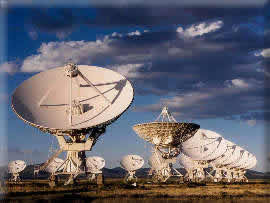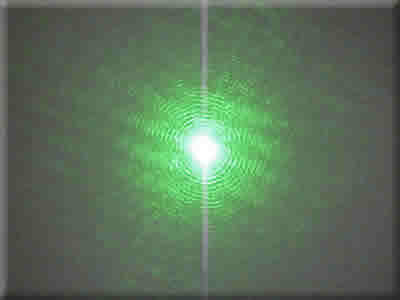S.E.T.I. Redux (The New and Improved SETI)
"So what's new with SETI?"
12.30.04
 It's an easy question: a query that the media frequently pose, and for obvious reasons. Of course, it would be nice to say, "well, we detected three Type II civilizations last week, but they weren't especially interesting," and sometimes I do this for effect. But of course it's not true, and until it is, some people assume that there's nothing new with SETI. It's an easy question: a query that the media frequently pose, and for obvious reasons. Of course, it would be nice to say, "well, we detected three Type II civilizations last week, but they weren't especially interesting," and sometimes I do this for effect. But of course it's not true, and until it is, some people assume that there's nothing new with SETI.
Wrong. Despite all the difficulties that beset it (mostly connected with funding), SETI is currently experiencing a paroxysm of creative ferment. The new year is sure to be memorable, as glossy new instruments come on-line. Success in SETI depends on speed: how quickly can you check out large expanses of celestial acreage? Well, SETI is about to seriously crank up its speed, and metaphorically trade in chariots for jets.
At Harvard University, a survey telescope designed to sweep massive swaths of the sky in a hunt for extraterrestrial laser flashes is becoming a reality. In Puerto Rico, the famed Arecibo telescope is getting a new feed that will speed up searches by seven times. And in California, the SETI Institute and Berkeley's Radio Astronomy Lab will soon be scanning the star-clotted realms of the inner Milky Way with the first-stage implementation of the Allen Telescope Array (ATA).
The ATA, as readers who have props on their beanies know, will eventually boast 350 antennas, each 20 feet in diameter. This impressive antenna farm will be spread over about a half square-mile of terrain.
There are good reasons for building an array, as such a phalanx of antennas is called, rather than a single, large dish. But those reasons may not be obvious. Perhaps you think that, when it comes to hunting for alien transmitters, all that counts is picking up enough radio photons to find the signal. If so, then the sole index of merit for a SETI radio telescope should be its size - the total acreage of its antennas. This is akin to claiming that the only thing that counts in wrestling is weight. As it happens, the ATA weighs in well: its collecting area will eventually be comparable to the new Green Bank Telescope in West Virginia, or the Very Large Array in New Mexico, both top-of-the-line research instruments.

But while size matters, it's not the only item checked on the ATA's feature list. Building an array offers at least three major advantages over a single-dish antenna of the same collecting area:
1. Because the ATA's individual antennas are relatively small, the field of view of the instrument is very wide (degrees across at some wavelengths). Just about everyone has peered through cheap binoculars having only a narrow field of view. They don't peer long.
2. As an array, the ATA can make maps of the sky. In other words, it's like a radio camera, producing images. Now that's rather different than a single-dish instrument, which can be likened to looking at the sky through a three-foot long soda straw. With that kind of setup, you only measure one small spot on the sky at a time. But if you really want a picture of what you're looking at, you need more than a single spot measurement.
OK, you discreetly protest, but making maps of the sky isn't what SETI's about, is it? That's for the radio astronomers interested in charting galaxies or nebulae. Well, as it turns out, the ability to break up a large field of view into small (radio) pixels is also good for the SETI crowd. Consider this: you're a radio astronomer, and your day job is mapping stuff like the Andromeda galaxy. You want your radio pixels to be in a regular, row-and-column matrix, like the members of a marching band. It's a pixel arrangement similar to what your digital camera's CCD has.
Fine. But for SETI purposes, you could spread the pixels around a bit, like a few grains of sand thrown onto a black piece of paper. The idea is to arrange those pixels to land on nearby stars - the very neighborhoods you wish to search for alien-generated signals. So now instead of having one soda straw to view the sky, you have a fist-full, each carefully aimed at a likely stellar system.

Another benefit of this capability is that, since these radio pixels are produced with computation, rather than being etched on silicon, you can make negative pixels - small patches of sky where you don't pick up any signals. That's useful not so much for blocking unsavory signals from tasteless extraterrestrials, but rather for blocking the interfering screech of our own, orbiting telecommunications satellites.
3. The mass of steel required to keep a big radio reflector from sagging or collapsing (always a drag) increases rapidly with size. So consider the following gedanken experiment: instead of building one large antenna, you build two smaller ones, each with half the collecting area. The acreage of each dish is now down by a factor of two, but the amount of steel in each is down by a factor of nearly three. So the two dishes together weigh less than the larger single one.
It's an exercise left to the student to extend this argument to yet smaller dishes, but clearly the advantage of doing so accumulates. The bottom line is the bottom line: it's less expensive to build lots of small antennas than one big one, even when the total collecting area is the same.
The ATA is enjoying its first growth spurt, and by spring will consist of 33 antennas, equivalent in collecting area to a 100-foot antenna. That's large enough to do serious science, and the array's first SETI assignment will be to slowly scan the flat, inner sections of the Milky Way. This is a test bed project certainly, but it's also a valuable SETI experiment. And as the ATA continues to expand, so do its speed and abilities.
No, it's not the discovery of yet another Type II civilization. But it's a breathtaking step toward making such discoveries happen. So you see, there is news. By Seth Shostak
SETI Institute
Related: SETI Signal Discovered
Related: NASA Cuts: SETI Seeks Private Funding
|

